Atlanta meteori
Roger R. SeapyIntroduction
Atlanta meteori attains a maximal shell diameter of 4 mm. The shell is transparent and colorless, and the walls are thin and fragile. The surface of the shell is smooth, without any sculpture. The keel is tall, with a truncate leading edge. The keel inserts between the penultimate and last shell whorls in shells larger than about 2 mm. The shell spire is comprised of about 5-1/2 to 5-3/4 whorls, and is strongly tilted relative to the shell plane. The spire is conical, with a rounded apex and an apical angle of 60-70°. The spire sutures are very shallow, with the result that the whorls are difficult to distinguish when the shell is viewed from the side. The umbilicus is very small and narrow. Eyes type b; lens conspicuously large in adults. Operculum type b; very thin and fragile. Radula type II and narrow, with a growth angle of 12-14°. Radulae not sexually dimorphic. Lateral teeth with accessory cusps. Marginal teeth with long, straight shafts and sharply bent hooks. Rachidian teeth broad and with a long median cusp. Atlanta meteori was previously considered to be an Indo-Pacific species in tropical to subtropical waters, but with its identification off northwestern Africa, it must now be regarded as cosmopolitan.
Diagnosis
- Shell diameter to 4 mm
- Shell transparent and colorless
- Surface of shell smooth, lacking sculpture
- Keel tall with truncate leading edge
- Keel penetrates between penultimate and last whorls in shells larger than about 2 mm
- Shell spire strongly tilted relative to shell plane
- Spire consists of 5-1/2 to 5-3/4 whorls
- Spire shape conical, with a rounded apex and an apical angle of 60-70°
- Spire sutures very shallow and difficult to resolve when shell is viewed from the side
- Umbilicus very small and narrow
- Eyes type b
- Operculum type b
- Radula type II
- Radula narrow, with a growth angle of 12-14°
- Lateral teeth with accessory cusps
- Marginal teeth with long, straight shafts and sharply bent hooks
- Rachidian teeth broad, with long median cusp
Characteristics
- Shell
- Shell of moderate size (to 4 mm diameter)
- Shell transparent and colorless
- Shell fragile, with thin walls
- Keel tall, with a truncate leading edge that begins nearly 1/4 whorl from the shell aperture (see title illustration)
- Keel penetrates between penultimate and last whorls in shells larger than about 2 mm (see first SEM below)
- Spire strongly tilted relative to shell plane (see third SEM below)
 Click on an image to view larger version & data in a new window
Click on an image to view larger version & data in a new window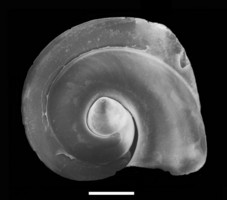
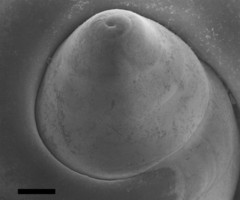
Figure. Shell of Atlanta meteori; views of the right side (left) and spire (right). Scale bars = 0.5 mm and 0.1 mm, respectively. © Roger R. Seapy
 Click on an image to view larger version & data in a new window
Click on an image to view larger version & data in a new window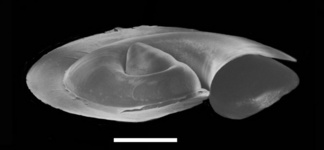
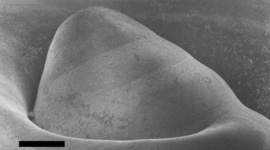
 Click on an image to view larger version & data in a new window
Click on an image to view larger version & data in a new windowFigure. Shell of a 3.7 mm Atlanta meteori; views of the right side, tilted (left) and the spire, tilted (right). Scale bars = 0.5 mm and 0.1 mm, respectively. © Roger R. Seapy
- Spire of about 5-1/2 to 5-3/4 whorls
- Spire conical in side view, with an apical angle of 60-70°. Richter (1990) characterized the apical angle as 70°, and this value is in agreement with the apical angles of the adult shells shown above and in the spire photograph below. However, Richter's photographs of larval shells (see fourth SEM above and transmitted light photograph below) have apical angles of about 60°. Without pursuing an explanation for this discrepancy, the apical angle is given here as 60-70°
- Spire sutures very shallow, with the result that when the spire is viewed from the side, the sutures are difficult to distinguish (see SEMs of adult and larval shells above)
 Click on an image to view larger version & data in a new window
Click on an image to view larger version & data in a new window - Internal walls of spire intact (see transmitted light photograph below); not decalcified as in A. inclinata and A. tokiokai
- Left side of shell with a very small and narrow umbilicus
 Click on an image to view larger version & data in a new window
Click on an image to view larger version & data in a new window Click on an image to view larger version & data in a new window
Click on an image to view larger version & data in a new windowFigure. Shell of Atlanta meteori; views of left side of shell (left) and umbilical region (right). Scanning electron micrographs from G. Richter (1990, figs. 8 and 20), modified by 180° rotation of second photograph and addition of scale bars (= 1.0 mm and 250 µm, respectively). © 1990 G. Richter
- Eyes type b
- Lens conspicuously large in adults, suggesting that the species prefers deeper daytime depths (Richter, 1974)
- Operculum type b
- Operculum thin and fragile
- Radula type II
- Radula with a growth angle of 12-14°; slightly narrower than in A. gibbosa
- Radulae of males and females show no sexual dimorphism
- Lateral teeth with accessory cusp (see label on SEM below)
- Rachidian teeth with a tall median cusp; in contrast with the short median cusp in A. gibbosa
Comments
Atlanta meteori shares a number of features with A. gibbosa. Both species have: (1) the same maximal shell size, (2) a transparent, colorless shell with thin, fragile walls, (3) a tall keel with a truncate leading edge, (4) a keel that penetrates between the last two whorls in shells larger than about 2 mm, (5) intact internal spire walls; not decalcified as in A. inclinata and A. tokiokai, and (6) the same eye, operculum and radular types. They differ, however, in several ways: (1) the apical angle of the shell spire is much narrower in A. meteori (60-70°) than in A. gibbosa (85°), (2) the spire is more steeply inclined relative to the shell plane in the former than in the latter species, (3) the spire sutures are very shallow in A. meteori and moderately incised in A. gibbosa, (4) the umbilicus is very small and narrow in A. meteori and very wide and deep in A. gibbosa, (5) there is no sexual dimorphism in the radulae of the former species , while the radular shape and tooth morphologies show strong sexual differences in the latter one , (6) the rachidian teeth have a notably longer median cusp in the former than in the latter species.
Historically, Atlanta meteori has been reported only from the Indian and Pacific Oceans. However, in a survey of the heteropod fauna of waters around the Selvagens Islands in the eastern North Atlantic, it was recorded by de Vera et al. (2006). Thus, the species must now be regarded as cosmopolitan, although possibly rare in the Atlantic Ocean.
In Hawaiian waters, the abundances and diel vertical distribution of Atlanta meteori were studied by Seapy (1990, 2008). In the first paper it was found to range downward during the day from a depth interval of 45-90 m to the maximal depth interval sampled (200-300 m) in low abundances (less than 1.5 individuals per 1,000 m3). At night there was a strong upward migration into the upper 140 m, with most individuals (85%) between the surface and 90 m and with the highest abundance (5 individuals per 1,000 m3) between the surface and 45 m. In the latter paper, A. meteori also occurred in low abundances (less than 4 individuals per 1,000 m3) at stations located 1, 5, and 15 nmi offshore. At all three stations there was evidence of strong nocturnal vertical migration, as found in the previous paper.
References
de Vera, A., R. R. Seapy, and F. Hernandez. 2006. Heteropod molluscs from waters around the Selvagens Islands (Gastropoda: Carinarioidea). Vieraea 34:33-43.
Richter, G. 1972. Zur Kenntnis der Gattung Atlanta (Heteropoda: Atlantidae). Archiv für Molluskenkunde 102(1/3): 85-91.
Richter, G. 1974. Die Heteropoden der "Meteor" Expedition in den Indischen Ozean 1964/65. "Meteor" Forschungs-Ergibnisse Ser. D, No. 17, pp. 55-78.
Richter, G. 1990. Zur Kenntnis der Gattung Atlanta (IV). Die Atlanta inclinata-Gruppe (Prosobranchia: Heteropoda). Archiv für Molluskenkunde 119: 239-275.
Richter, G. and R. R. Seapy. 1999. Heteropoda, pp. 621-647. In: D. Boltovskoy (ed.), South Atlantic Zooplankton. Backhuys Publishers, Leiden.
Seapy, R. R. 1990. Patterns of vertical distribution in epipelagic heteropod molluscs off Hawaii. Marine Ecology Progress Series 60: 235-246.
Seapy, R. R. 2008. Offshore-inshore and vertical distributional patterns of heteropod mollusks off leeward Oahu, Hawaii. Marine Biology 154: 985-995.
Title Illustrations

| Scientific Name | Atlanta meteori |
|---|---|
| Location | Indian Ocean |
| Life Cycle Stage | adult |
| Body Part | shell of holotype specimen |
| View | right side |
| Size | 3.7 mm diameter |
| Copyright | © 1972 G. Richter |
About This Page
Roger R. Seapy

California State University, Fullerton, California, USA
Correspondence regarding this page should be directed to Roger R. Seapy at
rseapy@fullerton.edu
Page copyright © 2011 Roger R. Seapy
 Page: Tree of Life
Atlanta meteori .
Authored by
Roger R. Seapy.
The TEXT of this page is licensed under the
Creative Commons Attribution License - Version 3.0. Note that images and other media
featured on this page are each governed by their own license, and they may or may not be available
for reuse. Click on an image or a media link to access the media data window, which provides the
relevant licensing information. For the general terms and conditions of ToL material reuse and
redistribution, please see the Tree of Life Copyright
Policies.
Page: Tree of Life
Atlanta meteori .
Authored by
Roger R. Seapy.
The TEXT of this page is licensed under the
Creative Commons Attribution License - Version 3.0. Note that images and other media
featured on this page are each governed by their own license, and they may or may not be available
for reuse. Click on an image or a media link to access the media data window, which provides the
relevant licensing information. For the general terms and conditions of ToL material reuse and
redistribution, please see the Tree of Life Copyright
Policies.
- First online 17 July 2010
- Content changed 23 July 2011
Citing this page:
Seapy, Roger R. 2011. Atlanta meteori . Version 23 July 2011 (under construction). http://tolweb.org/Atlanta_meteori/28766/2011.07.23 in The Tree of Life Web Project, http://tolweb.org/




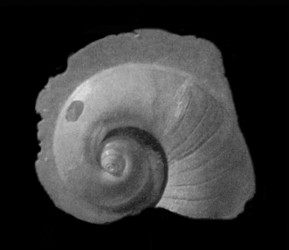
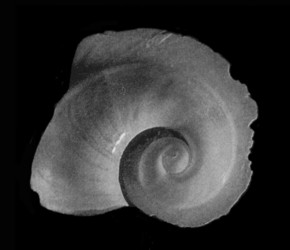
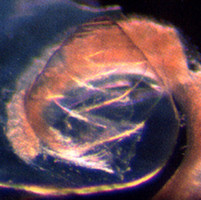
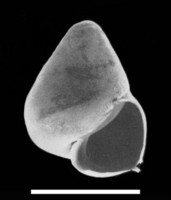
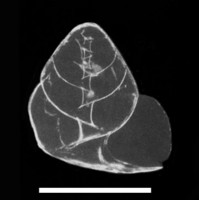
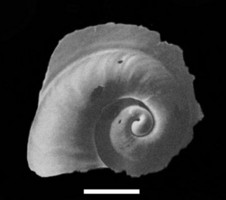
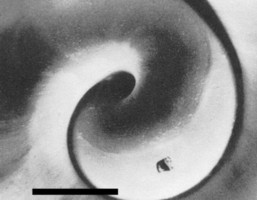
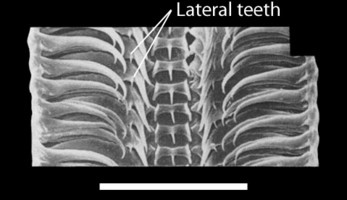

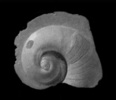



 Go to quick links
Go to quick search
Go to navigation for this section of the ToL site
Go to detailed links for the ToL site
Go to quick links
Go to quick search
Go to navigation for this section of the ToL site
Go to detailed links for the ToL site